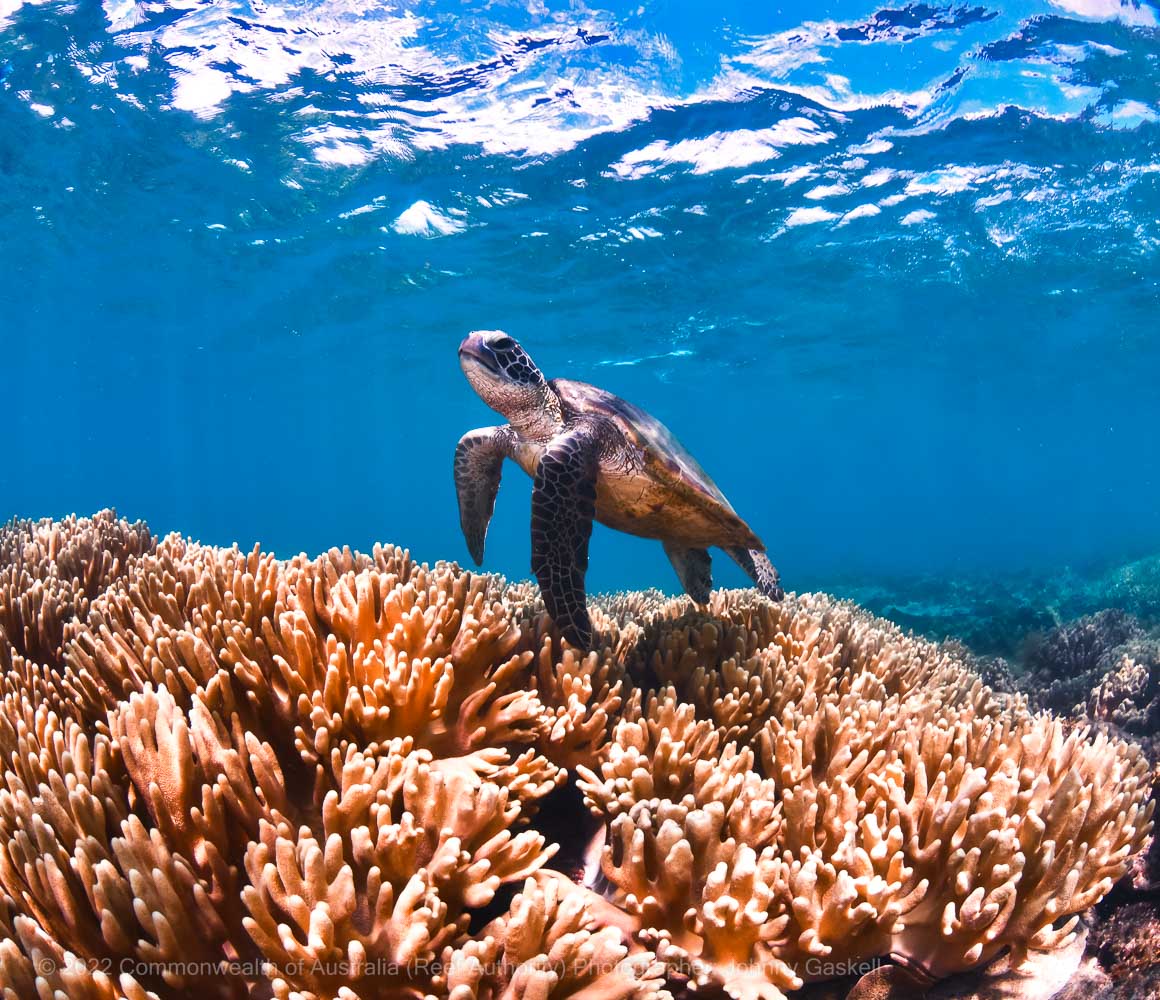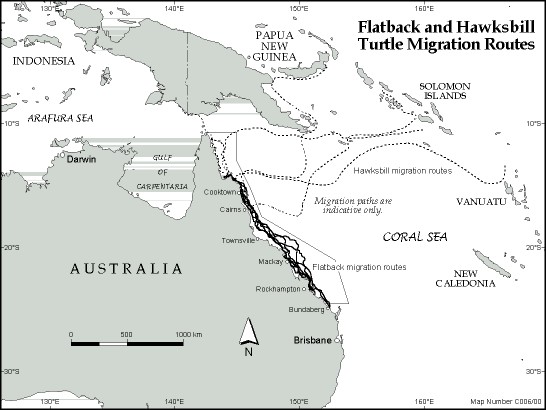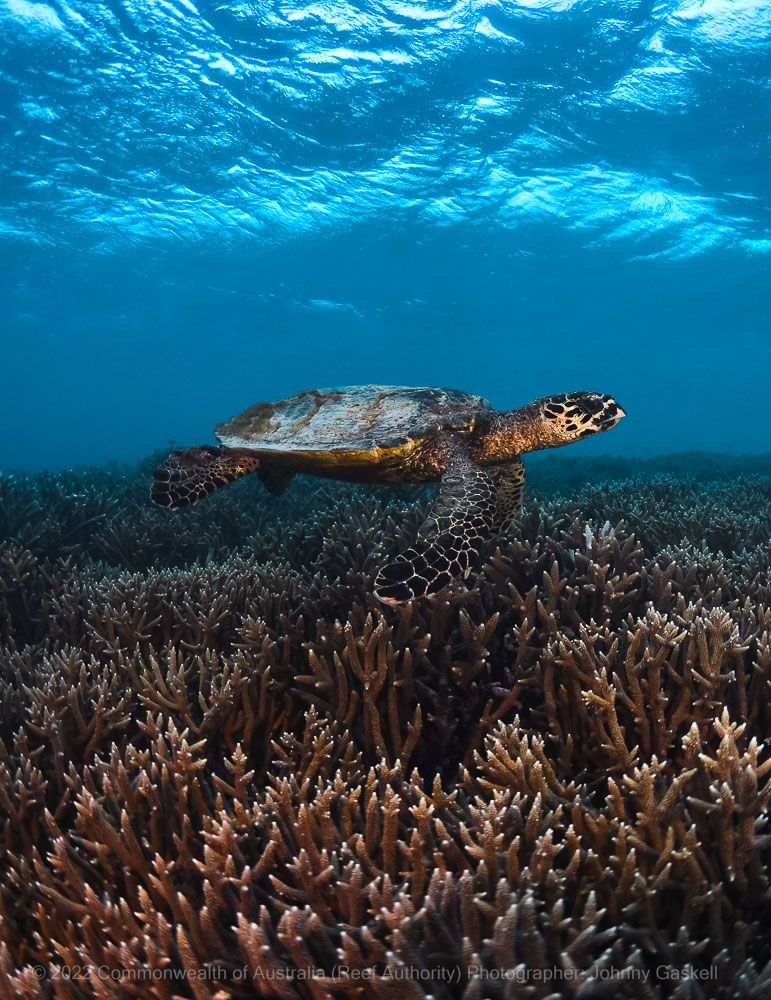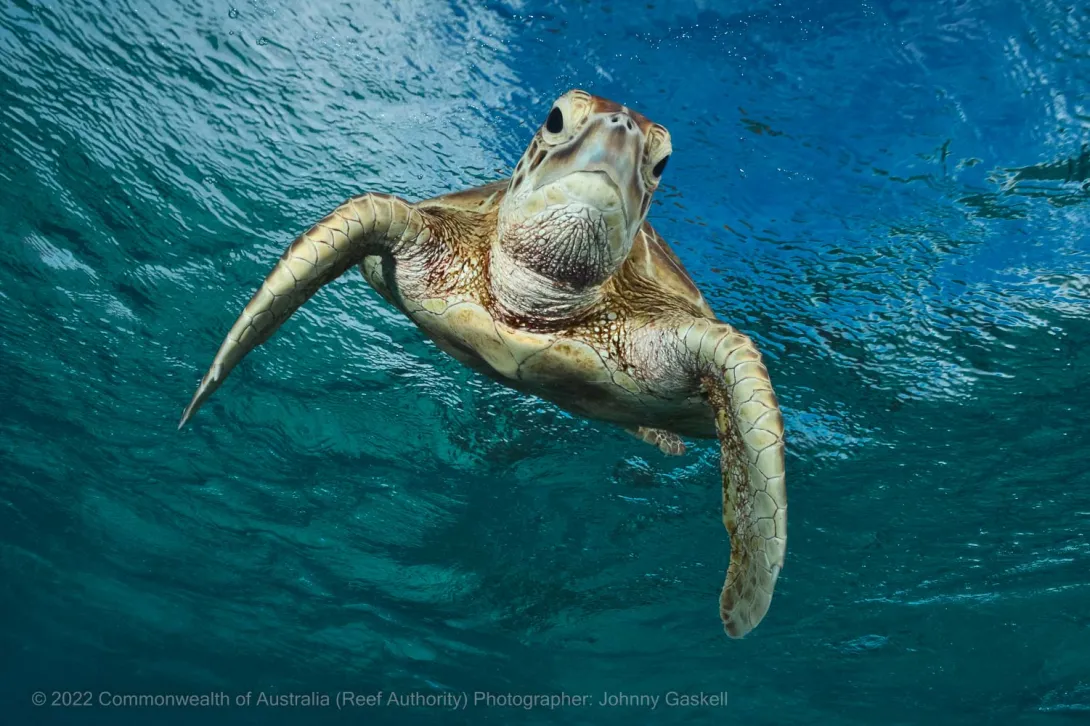Marine turtles are often called the ancient mariners of the sea. They have been swimming in the sea for more than 150 million years, first appearing during the age of the dinosaurs.
Turtles have changed little over the millennia, now only coming ashore to lay eggs, producing another generation to swim the seas.
Much of the information known about marine turtles in the Great Barrier Reef World Heritage Area comes from research conducted over the past 30 years by the Queensland Turtle Conservation project of the Department of Environment and Heritage Protection and from the local knowledge of Indigenous people and fishers.





How many marine turtles are found on the Reef
Six of the world’s seven species of marine turtle live in the waters around Australia, and all occur within the Great Barrier Reef World Heritage Area.
Some species such as the loggerhead and green turtle are seen frequently, while others such as the olive ridley and leatherback are known to occur in the Great Barrier Reef but are seldom seen. You can find out how to distinguish each species with the marine turtle identification sheet.
- Green turtle
- Loggerhead turtle
- Hawksbill turtle
- Flatback turtle
- Olive ridley turtle
- Leatherback turtle
Life cycle of marine turtles
All species of marine turtles have the same general life cycle. They grow slowly and take decades to reach sexual maturity.
As immature turtles, they may drift on ocean currents for many years or live for years in the one place before maturing and making a long breeding migration of up to 3000km from their feeding ground to a nesting beach.
At an unknown age (believed to be between 20 and 50 years) male and female turtles migrate to a nesting area located in the region of their birth. Both male and female turtles mate with a number of partners. The females store sperm in their bodies to fertilise the three to seven clutches of eggs laid during the season.
Mating generally takes place offshore a month or two prior to the turtle's first nesting attempt for the season, usually in summer.
Male turtles generally return to their foraging areas once the females commence their fortnightly trips to the beach to lay eggs. When ready, a female turtle crawls out of the sea and uses her front flippers to drag herself up the beach to a nest site.
The female digs out a body pit with her front flippers and then excavates a vertical egg chamber (between 30 and 60cm deep) with her hind flippers. If the sand is too dry and unsuitable for nesting, the turtle moves on to another site.
For most turtles, digging the nest takes about 45 minutes. Another ten to 20 minutes are then spent laying the clutch of leathery-shelled eggs. Each clutch contains about 120 eggs, ranging in size from the golf ball-sized egg of the hawksbill to the billiard ball-sized egg of the flatback.
After laying, the turtle fills the egg chamber with sand using her hind flippers, and then fills the body pit using all four flippers. The turtle finally crawls back to the sea about one to two hours after emerging, entering the surf exhausted.
In this offshore area she begins to make the next clutch of eggs, fertilising them from her sperm store. After the nesting season, females return to their distant foraging areas and may not nest again for two to eight years.
The temperature of the nest during incubation determines the sex of hatchlings. Warm, dark sand produces mostly females. Eggs laid in cool, white sand result mostly in males and generally take longer to hatch.
After about seven to 12 weeks the eggs hatch. The hatchlings take two or more days to reach the surface where they emerge as a group, usually at night.
To find the sea, hatchlings orient towards the brightest direction and use the topography of the surrounding horizon line. Once in the sea, hatchlings use a combination of cues (wave direction, current, and magnetic fields) to orient themselves to deeper offshore areas. Crossing the beach and swimming away is believed to imprint the hatchlings with the cues necessary to find their way back when they are ready to breed.
Once in the ocean, hatchlings are believed to enter regions where ocean currents meet. There they associate with floating seaweed mats and other flotsam caught up in ocean currents. Here they feed on tiny sea animals.
The hatchlings are rarely seen again until their shell length is 20-40cm, which may be five or 10 years after hatching. At this time, the young, free-swimming turtles migrate back to inshore foraging areas. They remain in these areas until they are ready to breed and the cycle begins again.
Common name: Green turtle
Scientific name: Chelonia mydas
IUCN (World Conservation Union): Endangered
Australian Environment Protection and Biodiversity Conservation Act 1999: Vulnerable
Queensland Nature Conservation (Wildlife) Regulation 1994: Vulnerable
Adult green turtles have a smooth, high-domed carapace (shell), are olive green in colour, with occasional brown, reddish-brown or black highlights. Hatchlings have a black carapace with white margins around the carapace, flippers and on the plastron (bottom of shell).
Distribution and habitat
Green turtles are found in tropical, subtropical and temperate waters around the world and appear to be the most abundant of the six species of marine turtle found in the Great Barrier Reef World Heritage Area.
They are found in subtidal and intertidal coral and rocky reefs and seagrass meadows of the continental shelf. Green turtles are mostly herbivorous (plant eaters) as adults, eating algae, seagrass, mangrove fruit and jellyfish.
Two genetic stocks of green turtles breed within the Great Barrier Reef Marine Park, a southern and a northern stock. The southern stock has nesting concentrated in the Capricorn/Bunker group of islands, with an average annual nesting population estimated at 8000 females. The northern stock has nesting concentrated around Raine Island and Moulter Cay with an average annual nesting population of 30,000 females.
The proportion of a green turtle population that nests each year is highly variable and is influenced by variations in the El Niño Southern Oscillation (ENSO) Index. Green turtles are the only species of marine turtle for which this correlation has been shown and it may be based upon nutrition.
For green turtles nesting and foraging in the Great Barrier Reef Marine Park, research shows migration to Indonesia, Gulf of Carpentaria, Arnhem Land, Torres Strait, Papua New Guinea, the Solomon Islands, Vanuatu and New Caledonia.
Figure 1 Indicative migration path of Great Barrier Reef green turtles

Dashed lines (- - -) represent movements of southern Great Barrier Reef green turtles. Solid lines (-) represent movements of northern Great Barrier Reef green turtles.
All migration paths are indicative only.
Breeding areas
Low density nesting occurs on many islands and along Queensland's coastline (Figure 2). Although genetically distinct nesting aggregations are known, the stocks often occur in the same foraging habitat (feeding area).
To date, there have been no detectable declines in the number of nesting green turtles at Great Barrier Reef nest monitoring sites. However, the 20 to 25 years of data for the key sites (Raine Island, Heron Island) do not cover a single generation for green turtles, and trends are difficult to determine with the large fluctuations in nesting numbers that can occur because of the El Niño Southern Oscillation.
Additionally, research suggests that the northern and southern stocks may be exhibiting characteristics of populations under threat, including a decline in the size of nesting adults, increases in the non-breeding periods and a lack of expected increases of turtle numbers in dispersed feeding areas. In addition, climate change may be adversely affecting nesting success by, for example, increased flooding of nest chambers and altering chamber temperatures thus affecting the sex of hatchlings.
Figure 2: Great Barrier Reef green turtle nesting sites

Green turtle facts
- Breeding season - Late October to February
- Years between breeding - Two to eight years
- Ages when female first breeds - 45 years
- Age when move into feeding area - Four to seven years (30 - 40cm carapace length)
- Nesting female length - 107cm (range from 91 - 124cm)
- Nesting female weight - 130kgs (range from 98 - 184kg)
- Clutch size (number of eggs) - 115 eggs (range from 62 - 153 eggs)
- Hatchlings emerge - December to May
- Hatchling success - 84 per cent
- Hatchling size - 4.97cm (range 4.02 - 5.19cm)
- Hatchling weight - (24.83g from 19.8 - 28.4g)
- Predators of hatchlings - Crabs, herons, dingoes and fish such as trevally and sharks

Common name: Loggerhead turtle
Scientific name: Caretta caretta
IUCN (World Conservation Union): Endangered
Australian Environment Protection and Biodiversity Conservation Act 1999: Endangered
Queensland Nature Conservation (Wildlife) Regulation 1994: Endangered
The loggerhead turtle is named for its large head. It has thick jaws that crush its food of crustaceans and molluscs. Adults are brown and are often highlighted with light brown, reddish-brown and black on their carapace (shell). The plastron (bottom of shell) is yellow. Hatchlings have a dark brown carapace and light brown plastron.
Distribution and habitat
Loggerhead turtles are found in all tropical and subtropical oceans. They inhabit subtidal and intertidal coral and rocky reefs and seagrass meadows as well as deeper soft-bottomed habitats of the continental shelf.
Loggerhead turtles feed on animals such as crabs, sea urchins, and jellyfish. Two genetic stocks inhabit Australian waters, one on the east coast and the other on the west coast.
For loggerhead turtles nesting and foraging in the Great Barrier Reef World Heritage Area, research shows migration to the Gulf of Carpentaria, Arnhem Land, Torres Strait, and Papua New Guinea.
Figure 1 Indicative migration path of Great Barrier Reef loggerhead turtles

All migration paths are indicative only.
Breeding areas
In Queensland, breeding and nesting occurs mainly in the southern Great Barrier Reef (Capricorn/Bunker group) and adjacent mainland near Bundaberg (Figure 2). Approximately 95 per cent of all nesting marine turtles on the Bundaberg coast are loggerheads. A few hundred females now nest annually in the region.
The eastern Australian loggerhead turtle nesting beaches support the only significant stock of the species in the South Pacific Ocean.
Population decline
The population has declined since the 1970s from about 1000 breeding females. This, combined with the long time before their first breeding (age around 20 years) and low reproductive rate (breeding every two to five years), means tthe remaining loggerhead population is at serious risk of extinction from any increases in mortality.
An annual loss of only a few loggerhead turtles could result in the extinction of the Queensland population. As female turtles return to nest in the area where they hatched, it is highly unlikely a population that has ‘died out’ would be recolonised by turtles from another population somewhere else in the world.
Evidence for recovery
The mandatory use of turtle excluder devices in the Queensland East Coast Otter Trawl Fishery was implemented in 2001. This reduced the incidental capture and mortality of sub-adult and loggerhead turtles.
With this major reduction in loggerhead turtle mortality, the nesting population increased over the next few years because more sub-adult turtles were able to become breeding adults and more adult turtles were able to complete their migrations to the nesting beaches.
Fox baiting programs implemented at mainland nesting beaches along the Bundaberg coast have positively influenced the success of loggerhead turtle nesting.
Figure 2: Great Barrier Reef loggerhead turtle nesting sites

Loggerhead turtle facts
- Breeding season - Late October to early March, peaking in December
- Years between breeding - Two to four years
- Ages when female first breeds - 20 to 25 years
- Age when move into feeding area - About 15 years (60cm carapace length)
- Nesting female length - 95.9cm (range from 85 - 108cm)
- Nesting female weight - 99kgs (range from 76 - 149kg)
- Clutch size (number of eggs) - 127 eggs (range from 89 - 151 eggs)
- Hatchlings emerge - December to April
- Hatchling success - 80 per cent
- Hatchling size - 4.33cm (range 4.13 - 4.49cm)
- Hatchling weight - (19.2g from 17 - 20.4g)
- Predators of hatchlings - Foxes, kookaburras, crows, raptors, gulls, reef egrets, phost crabs, fish such as trevally and sharks
Low Glow collaboration project to protect loggerhead turtles
The Low Glow collaboration project is based in the Bundaberg region and aims to improve nesting success and hatchling survivorship of loggerhead turtles at Mon Repos beach on the Woongarra coast — a very significant site for the Region’s loggerhead turtle population.
Ambient night-time light negatively affects female turtles’ nesting and can confuse hatchlings emerging from nests. Reef Guardian Schools around Bargara, Burnett Heads and Elliot Heads conduct light audits on their homes, schools and in their community during nesting season (October–December) and hatching season (January–March).
The data captured will help local residents and organisations to ‘cut the glow’ of ambient light. The project brings together Reef Guardian Schools, a Reef Guardian Council, Queensland Parks and Wildlife Junior Turtle Rangers and the Burnett Local Marine Advisory Committee, working in partnership for a more sustainable future for local nesting turtles.
Common name: Hawksbill turtle
Scientific name: Eretmochelys imbricata
IUCN (World Conservation Union): Critically Endangered
Australian Environment Protection and Biodiversity Conservation Act 1999: Vulnerable
Queensland Nature Conservation (Wildlife) Regulation 1994: Vulnerable
Adult hawksbill turtles have extensively variegated patters of brown and black on their carapace (shell). The plastron (bottom of shell) is cream with occasional black spots. A distinguishing feature of the hawksbill turtle is their beak-like mouth and narrow head. The carapace has overlapping scutes made of material much like fingernails. Hatchlings are dark brown.
Distribution and habitat
Hawksbill turtles occur in all oceans usually in tidal and sub-tidal coral and rocky reefs in tropical and subtropical areas. In Australia, hawksbills feed in rocky areas and on coral reefs. Their main feeding area is on the east coast, including the Great Barrier Reef.
Sponges make up a major part of the hawksbill's diet, although they also feed on seagrasses, algae, sea cucumbers, soft corals and shellfish. The pointed jaws are well adapted to prising food from crevices in and around coral.
Research on hawksbill turtles that nest or forage in the Great Barrier Reef Marine Park shows migration to Indonesia, Papua New Guinea, the Solomon Islands, and Vanuatu (Figure 1).
Breeding areas
Hawksbill turtles are found all over the world. The entire far northern section of the Great Barrier Reef Marine Park and the Torres Strait region is internationally significant for hawksbill turtle nesting as numbers have declined in many parts of the world.
There are three main breeding areas in Australia - northern Great Barrier Reef (several thousand nesting females), north-eastern Arnhem Land (about 2000 nesting females), and Western Australia (several thousand nesting females).
Hawksbill turtles tend to nest in low numbers and in the Great Barrier Reef Region. Nesting areas mainly occur north of Princess Charlotte Bay and in the Torres Strait (Figure 2).
The only Great Barrier Reef nesting population for which there is sufficient information is at Milman Island, where data indicates since 1990 numbers of nesting females have been declining at about three per cent each year.
Figure 1 Indicative migration path of Great Barrier Reef flatback and hawksbill turtles

Dashed lines (- - -) represent movements of hawksbill turtles.
Solid lines (-) represent movements of flatback turtles.
All migration paths are indicative only.
Hawksbill turtles facts
- Breeding season - Year round, concentrated from November to February
- Years between breeding - Two to five years
- Ages when female first breeds - 30 - 35 years
- Age when move into feeding area - Four to seven years (30cm carapace length)
- Nesting female length - 81.6cm (range from 63.5 - 91cm)
- Nesting female weight - 50.4kgs (range from 32 - 72kg)
- Clutch size (number of eggs) - 122 eggs (range from 18 - 210 eggs)
- Hatchlings emerge - Year-round concentrated from February to April
- Hatchling success - 79 per cent
- Hatchling size - 3.98cm (range 3.2 - 4.36cm)
- Hatchling weight - 13.8g (range from 8 - 17.5g)
- Predators of hatchlings - Gulls, reef egrets, ghost crabs, crocodiles, fish, sharks, crabs and dingoes

Common name: Flatback turtle
Scientific name: Natator depressus
IUCN (World Conservation Union): Data deficient
Australian Environment Protection and Biodiversity Conservation Act 1999: Vulnerable
Queensland Nature Conservation (Wildlife) Regulation 1994: Vulnerable
The flatback turtle has a distinct low-domed flat carapace (shell) with upturned edges and covered by a thin skin and their plastron (bottom of shell) is white. Adults have olive grey flippers and head. Hatchlings are grey and have a white plastron.
Distribution and habitat
Flatback turtles are only found on the continental shelf of Australia. Although they feed around Papua New Guinea and Indonesia as well as within the Great Barrier Reef Marine Park, they nest only in Australia.
Hatchling flatback turtles are unique in that they do not have an oceanic pelagic phase, rather they are believed to inhabit inshore areas of clear reefal waters.
Flatback turtles inhabit subtidal soft-bottomed habitats of the continental shelf and feed on things such as soft corals, sea pens and jellyfish. Numbers in the east coast population in Queensland appear to be stable.
Tag returns up to 1300km between nesting and foraging areas have established movement between Australia and Indonesia (southern Irian Jaya) (Figure 1).
Breeding areas
All known breeding sites of the flatback turtle are in Australia. Breeding is centred in the southern Great Barrier Reef around Peak, Wild Duck, Curtis and Facing Islands (Figure 2).However, low density nesting by flatbacks occurs on many mainland beaches and offshore islands north of Gladstone.The largest amount of nesting occurs on Crab Island in western Torres Strait.
Whilst trends in population numbers of breeding flatback turtles are generally uncertain, their numbers are thought to be relatively stable on the Australian east coast including the Great Barrier Reef.
Figure 1 Indicative migration path of Great Barrier Reef flatback and hawksbill turtles

Dashed lines (- - -) represent movements of hawksbill turtles.
Solid lines (-) represent movements of flatback turtles.
All migration paths are indicative only.
Flatback turtle facts
- Breeding season - November to February
- Years between breeding - One to three years
- Ages when female first breeds - 20 years
- Nesting female length - 94cm (range from 88 - 96cm)
- Nesting female weight - 82kgs (range from 70 - 90kg)
- Clutch size (number of eggs) - 54 eggs
- Hatchlings emerge - January to April
- Hatchling success - 80 per cent
- Hatchling size - 6.1cm (range 5.66 - 6.55cm)
- Hatchling weight - 44g (range from 33.3 - 49.1g)
- Predators of hatchlings - Pelicans, ghost crabs, crocodiles and sharks
Common name: Olive ridley turtle
Scientific name: Leipdochelys olivacea
IUCN (World Conservation Union): Endangered
Australian Environment Protection and Biodiversity Conservation Act 1999: Endangered
Queensland Nature Conservation (Wildlife) Regulation 1994: Endangered
Common name: Leatherback turtle
Scientific name: Dermochelys coriacea
IUCN (World Conservation Union): Critically Endangered
Australian Environment Protection and Biodiversity Conservation Act 1999: Vulnerable
Queensland Nature Conservation (Wildlife) Regulation 1994: Endangered
Conservation status
The conservation status of marine turtle species found in the Great Barrier Reef World Heritage Area has been assessed by IUCN (the World Conservation Union), and by the Australian and Queensland governments.
IUCN Red List categories: Extinct, Extinct in the Wild, Critically Endangered, Endangered, Vulnerable, Lower risk, Data deficient (Source: 2008 IUCN Red List of Threatened Animals).
Australian Environment Protection and Biodiversity Conservation Act 1999 categories: Extinct, Extinct in the eild, Critically endangered, Endangered, Vulnerable, Lower risk, Data deficient.
Queensland Nature Conservation (Wildlife) Regulation 1994 schedules: Presumed extinct, Endangered, Vulnerable, Rare, Common.

